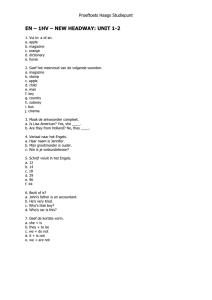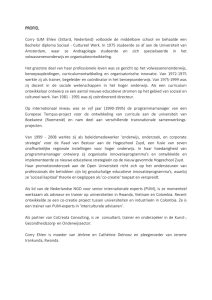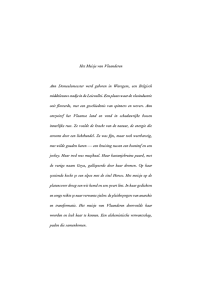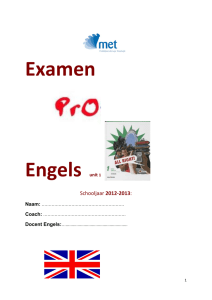handout meertens workshop doubling
advertisement
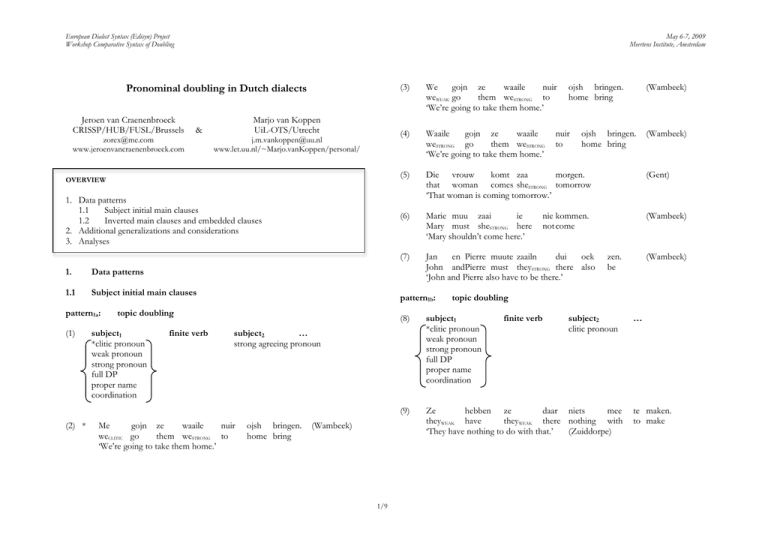
European Dialect Syntax (Edisyn) Project Workshop Comparative Syntax of Doubling May 6-7, 2009 Meertens Institute, Amsterdam Pronominal doubling in Dutch dialects Jeroen van Craenenbroeck CRISSP/HUB/FUSL/Brussels Marjo van Koppen UiL-OTS/Utrecht & zorex@me.com www.jeroenvancraenenbroeck.com j.m.vankoppen@uu.nl www.let.uu.nl/~Marjo.vanKoppen/personal/ OVERVIEW 1. Data patterns 1.1 Subject initial main clauses 1.2 Inverted main clauses and embedded clauses 2. Additional generalizations and considerations 3. Analyses 1. Data patterns 1.1 Subject initial main clauses pattern1a: (1) (2) * finite verb We gojn ze waaile nuir weWEAK go them weSTRONG to ‘We’re going to take them home.’ (4) Waaile gojn ze waaile weSTRONG go them weSTRONG ‘We’re going to take them home.’ (5) Die vrouw komt zaa morgen. that woman comes sheSTRONG tomorrow ‘That woman is coming tomorrow.’ (Gent) (6) Marie muu zaai ie Mary must sheSTRONG here ‘Mary shouldn’t come here.’ (Wambeek) (7) Jan en Pierre muute zaailn dui oek John andPierre must theySTRONG there also ‘John and Pierre also have to be there.’ pattern1b: topic doubling subject1 *clitic pronoun weak pronoun strong pronoun full DP proper name coordination (3) ojsh bringen. home bring (Wambeek) 1/9 nuir to (Wambeek) ojsh bringen. home bring nie kommen. not come zen. be (Wambeek) (Wambeek) topic doubling (8) subject1 *clitic pronoun weak pronoun strong pronoun full DP proper name coordination (9) Ze hebben ze daar niets mee theyWEAK have theyWEAK there nothing with ‘They have nothing to do with that.’ (Zuiddorpe) subject2 … strong agreeing pronoun Me gojn ze waaile nuir weCLITIC go them weSTRONG to ‘We’re going to take them home.’ ojsh bringen. home bring finite verb subject2 clitic pronoun … te maken. to make Jeroen van Craenenbroeck & Marjo van Koppen (10) Pronominal doubling in Dutch dialects Zij hebben ze daar niets mee theySTRONG have theyWEAK there nothing with ‘They have nothing to do with that.’ (Zuiddorpe) te maken. to make (15) (11) ?? Marie heeft ze daar niets mee te maken. Mary have sheWEAK there nothing with to make ‘They have nothing to do with that.’ (Koewacht) pattern2c: (13) subject1 *clitic pronoun weak pronoun strong pronoun full DP proper name coordination subject1 *clitic pronoun weak pronoun finite verb subject2 subject3 … clitic strong agreeing pronoun (17) Ze kent tet sheWEAK knows TET ‘She knows that.’ zij dat. sheSTRONG that (Lapscheure) pattern3: finite verb subject2 clitic pronoun subject3 strong nonagreeing pronoun 2/9 subject3 strong pronoun topic marking subject1 *clitic pronoun weak pronoun strong pronoun full DP proper name coordination sentence expletive (19) Marie eid ij ie niks te zuken. Mary has heSTRONG here nothing to seek ‘Mary has no business here.’ (Wambeek) (20) Dui stond ij een vrou inn of. there stood heSTRONG a woman in.the garden ‘There was a woman standing in the garden.’ (Wambeek) tripling subject1 *clitic pronoun weak pronoun strong pronoun full DP proper name coordination *sentence *expletive subject2 tet (18) We hebben me weir daar niks mee te maken. weWEAK have weCLITIC weSTRONG there nothing with to make ‘We have nothing to do with that.’ (Affligem) pattern2b: (14) finite verb tripling (16) pattern2a: tripling (12) Z’ ei se ‘d ij oek nie gemakkelijk. sheWEAK has sheCLITIC it heSTRONG also not easy ‘She’s not having an easy time either.’ (Wambeek) finite verb subject2 … strong non-agreeing pronoun tet Jeroen van Craenenbroeck & Marjo van Koppen (21) (22) 1.2 Me Jef klappen is ij nie belangrijk. with Jef talk is heSTRONG not important ‘To talk with Jef is not important.’ (Wambeek) clitic doubling complementizer finite verb subject1 clitic subject2 … strong pronoun coordination Zijn tet de studenten weg? are TET the students away ‘Have the students left?’ (Lapscheure) (30) … dad ij Jef oek mag that heSTRONG Jef also may ‘… that Jef is also allowed to come.’ (32) Ik paus da me t [gou en ik ] suimen I think that weCLITIC it youSTRONG and ISTRONG together kunn oplossen. can solve ‘I think that you and I can solve that together.’ (Wambeek) is. is PRT Ik paus da se [ zaailn en waailn] dui suimen I think that theyCLITIC theySTRONG and weSTRONG there together oitgeruiken out.come ‘ I think that they and we will solve that together.’ (Wambeek) wel PRT 3/9 subject2 … strong pronoun coordination full DP kommen. come topic marking complementizer finite verb subject1 clitic subject2 … strong non-agreeing pronoun tet Hoevele flassen ee-j tet gekocht? how.many bottles have-youCLITIC TET bought ‘How many bottles have you bought?’ pattern3: wel subject1 strong non-agreeing tet (29) (31) geweest been topic marking complementizer finite verb pattern2b: geweest. been subclauses (25) … da se zaai ie gisteren niet that sheCLITIC sheSTRONG here yesterdat not ‘… that she wasn’t here yesterday.’ (Wambeek) (27) (28) Inverted main clauses and embedded clauses inverted main clauses (24) Gisteren is se zaai ie nie yesterday is sheCLITIC sheSTRONG here not ‘She wasn’t here yesterday.’ (Wambeek) (26) pattern2a: Ge kent tet da. you know TET that ‘You know that.’ (Lapscheure) pattern1: (23) Pronominal doubling in Dutch dialects tripling (33) complementizer finite verb subject1 clitic subject2 strong non-agr. pronoun tet (34) … da-ze tet zie da that-sheCLITIC TET sheSTRONG that ‘…that she knows that.’ kent. knows subject3 strong pron. coordination Jeroen van Craenenbroeck & Marjo van Koppen Pronominal doubling in Dutch dialects 2. Additional generalizations and considerations 2.4 Is topic marking really subject doubling? 2.1 Only subjects can double arguments con: - (35) * Ik em I have ze ee gezien. herCLITIC herSTRONG seen INTENDED: ‘I saw her.’ argument pro: - the ‘doubling’ pronoun doesn’t agree in phi-features with the subject it has a different distribution from ‘genuine’ doubling pronouns (Haegeman 2008) it interacts with doubling in making possible otherwise illicit configurations: 2.2 Pronominal doubling is always optional (36) Marie muu (zaai) ie Mary must sheSTRONG here ‘Mary shouldn’t come here.’ (37) … da se (zaai) ie gisteren niet that sheCLITIC sheSTRONG here yesterdat not ‘… that she wasn’t here yesterday.’ (Wambeek) geweest been is. is (43) Z’ ei se ‘d ij sheWEAK has sheCLITIC it heSTRONG ‘She’s done it.’ (Wambeek) (38) … da (se) zaai ie gisteren niet that sheCLITIC sheSTRONG here yesterdat not ‘… that she wasn’t here yesterday.’ (Wambeek) geweest been is. is 2.5 Movement of the doubling or doubled element nie kommen. not come (Wambeek) (42) ?* Z’ ei se ‘t geduin. sheWEAK has sheCLITIC it done INTENDED: ‘She’s done it.’ (Wambeek) geduin. done disallowed in clitic doubling (39) … dad (ij) Jef oek mag kommen. that heSTRONG Jef also may come ‘… that Jef is also allowed to come.’ (Wambeek) (44) * Zaaile paus ek da-z ie nie geweest theySTRONG think I that-theyCLITIC here not been INTENDED: ‘They I don’t think were here.’ 2.3 Pronominal doubling is used to express ‘emphasis’ allowed in topic marking (40) Ze komd oek mergen. she comes also tomorrow ‘She’s also coming tomorrow.’ (45) (41) Ze komd zaai oek mergen. she comes zaai also tomorrow ‘In spite of what you might think, she’s also coming tomorrow.’ 4/9 Jef paus ek dad ij Jef think I that heSTRONG ‘Jef I think must also come.’ oek also muu kommen. must come zen. are Jeroen van Craenenbroeck & Marjo van Koppen 2.6 Pronominal doubling in Dutch dialects Tripling as the combination of two types of doubling (51) generally, tripling can be analyzed as the combination of two types of doubling … da-ze tet zie da that-sheCLITIC TET sheSTRONG that ‘…that she knows that.’ kent. knows pattern2a: tripling = topic doubling + clitic doubling exception: pattern2b: (46) subject1 *clitic pronoun weak pronoun strong pronoun full DP proper name coordination (52) subject1 *clitic pronoun weak pronoun strong pronoun full DP proper name coordination *sentence *expletive (47) We hebben me weir daar niks mee te maken. weWEAK have weCLITIC weSTRONG there nothing with to make ‘We have nothing to do with that.’ (Affligem) (53) Z’ ei se ‘d ij oek nie gemakkelijk. sheWEAK has sheCLITIC it heSTRONG also not easy ‘She’s not having an easy time either.’ (Wambeek) finite verb subject2 subject3 … clitic strong agreeing pronoun pattern2c: tripling = topic doubling + topic marking (48) subject1 *clitic pronoun weak pronoun finite verb (49) Ze kent tet sheWEAK knows TET ‘She knows that.’ zij dat. sheSTRONG that (Lapscheure) subject2 tet complementizer finite verb subject1 clitic 2.7 subject2 strong non-agr. pronoun tet subject2 clitic pronoun subject3 strong nonagreeing pronoun the dialect of Wambeek has no independent means of doubling a weak pronoun with a clitic (looks like Zeeland-style topic doubling) subject3 strong pronoun Correlations between tripling and other phenomena clitic doubling in infinitivals COMP-agreement tripling pattern3: tripling = clitic doubling + topic marking (50) finite verb subject3 strong pron. coordination 5/9 B-DIALECTS ✓ * ✓ A-DIALECTS * ✓ * Jeroen van Craenenbroeck & Marjo van Koppen Pronominal doubling in Dutch dialects B-DIALECTS (54) Me (se) zui te komme, … with theyCLITIC theySTRONG to come ‘Because of them coming, …’ (Brussels) when clitic doubling a coordination, either the first conjunct or the entire coordination can be doubled by the clitic A-DIALECTS (55) Mee (*se) zunder te komen with theyclitic theystrong to come ‘Because of them coming, …’ (Waregem) full coordination clitic doubling is only allowed when an object clitic intervenes between the clitic and the coordinated subject 2.9 (60)?* Ik venj I find da se aai en zaai da suimen muutn oplossen. that theyCLITIC [he and she] that together must solve INTENDED: ‘I think he and she should solve that together.’ (Wambeek) clitic doubling is disallowed in infinitival clauses in A-dialects. B-DIALECTS (56) Ik paus da(*-n) se zaailn kommen. I think that-PLURAL theyCLITIC theySTRONG come ‘I think they are coming.’ (Wambeek) A-DIALECTS (57) K peizn da-n ze zider komn. I think that-PLURAL theyCLITIC theySTRONG come ‘I think they are coming.’ (Wijtschate) First conjunct vs. Full coordination clitic doubling (58) Ik paus da me t [gou en ik ] suimen I think that weCLITIC it youSTRONG and ISTRONG together kunn oplossen. can solve ‘I think that you and I can solve that together.’ (Wambeek) (59) (61) Ik venj da se ‘t aai en zaai suimen muut oplossen. I find that theyCLITIC itCLITIC [he and she] together must solve ‘I think that he and she should solve that together.’ (Wambeek) 3. Analyses 3.1 Copy spell-out A. Proposed for: Topic Doubling complementizer agreement is only allowed in the A-dialects 2.8 Object clitic anti-intervention effects & full coordination clitic doubling B. How it works • The copy of the topicalized subject is spelled out by a strong subject pronoun (62) wel PRT Ik paus da se [ zaailn en waailn] dui suimen I think that theyCLITIC theySTRONG and weSTRONG there together oitgeruiken out.come ‘ I think that they and we will solve that together.’ (Wambeek) [CP waailei komme [AgrP waailei [VP … ]]] Copy Spell-Out: [CP waaile komme [AgrP waaile [VP … ]]] Arguments pro: • Restriction to Subject-Initial main clauses only sentence type in which Spec,CP is available for the subject. • Restriction to strong or generically interpreted weak quantifiers only those quantifiers can be topicalized wel PRT 6/9 Jeroen van Craenenbroeck & Marjo van Koppen (63) • (64) a. Alle / * gin manne meege zaailn all / no men may theySTRONG ‘All men can come in.’ (Wambeek) b. Een vrou komt zaai e kaffee a woman comes sheSTRONG a bar ‘Women usually enter a bar.’ # ‘A woman enters a bar.’ Pronominal doubling in Dutch dialects ie here binn inside (66) DP binn. in D • 3.2 φ Wie eid-ij da geduin? (Wambeek) who has-heSTRONG that done meaning: * ‘Who has done that?’ (real question) ‘It is obvious that X/no-one has done that.’ (rhetorical question) Die vrouw komt zaa morgen. that woman comes sheSTRONG tomorrow ‘That woman is coming tomorrow.’ • • • Clitic φ’ NP Arguments pro: • It explains why objects cannot be doubled object clitics are DPs according to the tests of Dechaine & Wiltschko (2002) • It explains why full DP-subjects/proper names cannot be doubled the NP contains lexical material and cannot be spelled out as a clitic. Arguments con: • Subject Island violation • CSC violation (with FCCD see above) • If this structure is also used for Topic Doubling how to explain Topic Doubling with non-weak pronouns? (Gent) It is unclear why objects cannot be doubled 3.3 Big DP Functional head A. Proposed for: Clitic Doubling & Topic Marking A. Proposed for: Clitic Doubling, Topic Doubling with weak subjects B. φP Meaning of a wh-question changes to a rhetorical question Arguments con: • The copy is not necessarily identical to the topicalized subject: (65) D’ Strong pronoun B. How it works How it works General idea: A subpart of the subject is moved out of the subject to a sentence initial position. Specific implementation: Based on the pronominal inventory of Dechaine & Wiltschko (2002): Strong subject pronouns are DPs, Subject clitics are φPs. Schematic structure of a Clitic Doubled strong subject pronoun: B1. Clitic Doubling the clitic spells out a functional head position (for instance Fin°) 7/9 Jeroen van Craenenbroeck & Marjo van Koppen (67) [CP [C° dat] [FinP [Fin° zek ] [IP that sheCLITIC ‘…that she sees that’ Pronominal doubling in Dutch dialects ziji [I° tk ] [vP sheSTRONG ti da that ziet]]]] sees (71) Arguments con: • No doubling of full DP-subjects • (69) da that zaaii … ]] she Spelling out of phi-features for emphatic reasons A. Proposed for: Topic Doubling with weak pronoun, Clitic Doubling B. How it works (72) a. Subject initial main clause [CP Zei [C° heeftk ti] [IP zij gisteren [VP ti [V° tk gewerkt]][I° tk]]]. b. Inverted main clause/embedded clause [CP Gisteren [C° heeftk zei] [IP zij [VP ti [V°gewerkt]][I° tk]]]. FCCD the features of the subject and hence of I° are not the features spelled out by the subject clitic. B2. Topic marking (70) [CP [C° da] [FP [F° tet ] [TP Valèrei [ that TET V. 3.4 3.5 * Ik paus da se [ Marie] komt I think that sheCLITIC Mary comes ‘I think that they and we will solve that together.’ Ik paus da se [ zaailn en waailn] I think that theyCLITIC theySTRONG and weSTRONG wel oitgeruiken PRT out.come ‘ I think that they and we will solve that together.’ zaaii [VP she Arguments pro: see 3.1 above Arguments con: • It is unclear how the relation between topic in Spec,CP and strong pronoun in Spec,IP is exactly established. • It is unclear why the second element of the doubled subject has to be a strong subject pronoun. • It is unclear why objects can be doubled Arguments pro: • It explains why there is no object Clitic Doubling I° agrees with the subject, not with the object. (68) [CP Mariei komt [IP M. comes dui suimen there together Arguments pro: • unification of Topic Doubling and Clitic Doubling Arguments con: • How to account for Topic Doubling with non-weak subjects? • No doubling of strong pronouns/proper names/full DP-subjects nie wilt doen]]] not wants do (73) Left dislocation A. Proposed for: Topic Doubling B. How it works • The first element of the doubled subject is base-generated in Spec,CP (satellite). • The subject pronoun moves from Spec,VP to Spec,IP • 8/9 * Ik paus da [zij] zij/Marie/die vrouw I think that sheSTRONG she/Mary/that woman ‘I think that they and we will solve that together.’ komt comes Coordination data (FCCD) shows that the strong pronoun in inverted main clauses/embedded clauses are is the thematic subject (rather than the clitic pronoun): Jeroen van Craenenbroeck & Marjo van Koppen (74) • (75) Pronominal doubling in Dutch dialects Ik paus da se [ zaailn en waailn] I think that theyCLITIC theySTRONG and weSTRONG wel oitgeruiken PRT out.come ‘ I think that they and we will solve that together.’ dui suimen there together Selected references Broekman, E. (2008). Subjectverdubbeling in enkele Zeeuws Vlaamse dialecten. BA-thesis, University of Utrecht. Craenenbroeck, J. van & M. van Koppen (2002). Pronominal doubling and the structure of the left periphery in Southern Dutch. S. Barbiers, L. Cornips & S. van der Kleij (eds.). Syntactic microvariation. Published at http://www.meertens.knaw.nl/books/synmic/. Craenenbroeck, J. & M. van Koppen (2008). Pronominal doubling in Dutch dialects: big DPs and coordinations. S. Barbiers e.a. (eds.). Microvariations in syntactic doubling. Syntax and Semantics vol. 36. Bingley: Emerald. 207-249. Haegeman, L. (2008). Pleonastic tet in West Flemish. S. Barbiers e.a. (eds.). Microvariations in syntactic doubling. Syntax and Semantics vol. 36. Bingley: Emerald. 277-300. Vogelaer, G. De & M. Devos (2008). On geographical adequacy, or: how many types of subject doubling in Dutch. S. Barbiers e.a. (eds.). Microvariations in syntactic doubling. Syntax and Semantics vol. 36. Bingley: Emerald. 251-276. Coordination data (FCCD vs FuCCD) shows that the strong pronoun in inverted main clauses/embedded clauses is not the same as the strong pronoun in subject initial main clauses: Jan en Pierre muute zaailn John and Pete must they ‘John and Pete must also be there!’ (76) * Ze muute They must Jan en Pierre dui John and Pete dui oek there also oek zen. there also zen. be be 9/9
